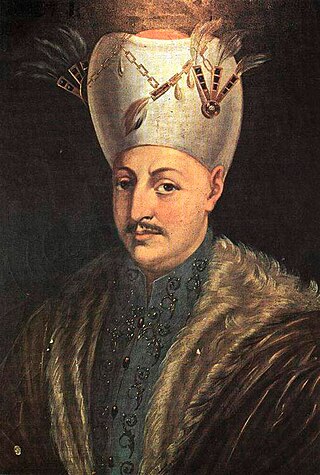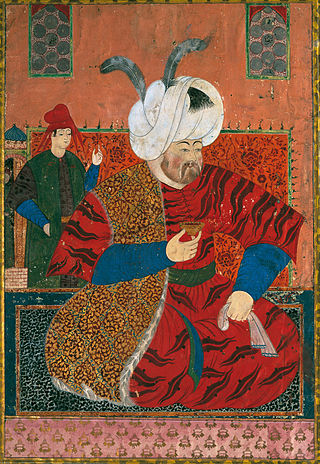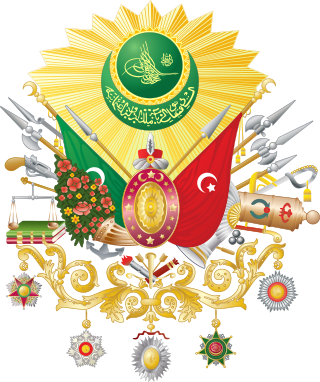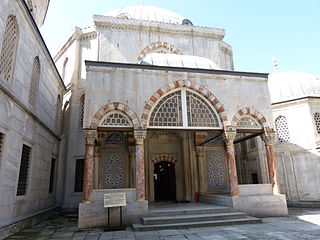Related Research Articles

Ahmed I was the sultan of the Ottoman Empire from 1603 to 1617. Ahmed's reign is noteworthy for marking the first breach in the Ottoman tradition of royal fratricide; henceforth, Ottoman rulers would no longer systematically execute their brothers upon accession to the throne. He is also well known for his construction of the Blue Mosque, one of the most famous mosques in Turkey.

Murad III was the sultan of the Ottoman Empire from 1574 until his death in 1595. His rule saw battles with the Habsburgs and exhausting wars with the Safavids. The long-independent Morocco was for a time made a vassal of the empire but regained independence in 1582. His reign also saw the empire's expanding influence on the eastern coast of Africa. However, the empire was beset by increasing corruption and inflation from the New World which led to unrest among the Janissary and commoners. Relations with Elizabethan England were cemented during his reign, as both had a common enemy in the Spanish. He was also a great patron of the arts, commissioning the Siyer-i-Nebi and other illustrated manuscripts.

Mehmed III was the sultan of the Ottoman Empire from 1595 until his death in 1603. Mehmed was known for ordering the execution of his brothers and leading the army in the Long Turkish War, during which the Ottoman army was victorious at the decisive Battle of Keresztes. This victory was however undermined by some military losses such as in Győr and Nikopol. He also ordered the successful quelling of the Jelali rebellions. The sultan also communicated with the court of Elizabeth I on the grounds of stronger commercial relations and in the hopes of England to ally with the Ottomans against the Spanish.

Selim II, also known as Selim the Blond or Selim the Drunkard, was the sultan of the Ottoman Empire from 1566 until his death in 1574. He was a son of Suleiman the Magnificent and his wife Hurrem Sultan. Selim had been an unlikely candidate for the throne until his brother Mehmed died of smallpox, his half-brother Mustafa was strangled to death by the order of his father and his brother Bayezid was killed on the order of his father after a rebellion against him and Selim.

Hagia Sophia, officially the Hagia Sophia Grand Mosque,(Turkish: Ayasofya-i Kebir Cami-i Şerifi; Greek: Μεγάλο Τζαμί της Αγίας Σοφίας), is a mosque and former church serving as a major cultural and historical site in Istanbul, Turkey. The last of three church buildings to be successively erected on the site by the Eastern Roman Empire, it was completed in AD 537, becoming the world's largest interior space and among the first to employ a fully pendentive dome. It is considered the epitome of Byzantine architecture and is said to have "changed the history of architecture". The site was an Eastern rite church from AD 360 to 1453, except for a brief time as a Latin Catholic church between the Fourth Crusade in 1204 and 1261. After the fall of Constantinople in 1453, it served as a mosque until 1935, when it became an interfaith museum, until being controversially reclassified solely as a mosque in 2020.
Sedefkar Mehmed Agha or Sedefqar Mehmeti of Elbasan is recorded as the Ottoman architect of the Sultan Ahmed Mosque in Istanbul.

Fatih is a municipality and district of Istanbul Province, Turkey. Its area is 15 km2, and its population is 368,227 (2022). It is home to almost all of the provincial authorities but not the courthouse. It encompasses the historical peninsula, coinciding with old Constantinople. In 2009, the district of Eminönü, which had been a separate municipality located at the tip of the peninsula, was once again remerged into Fatih because of its small population. Fatih is bordered by the Golden Horn to the north and the Sea of Marmara to the south, while the Western border is demarked by the Theodosian wall and the east by the Bosphorus Strait.

Hagia Sophia is a formerly Greek Orthodox church that was converted into a mosque following the conquest of Trabzon by Mehmed II in 1461. It is located in Trabzon, northeastern Turkey. It was converted into a museum in 1964 and back into a mosque in 2013. The building dates back to the thirteenth century, when Trabzon was the capital of the Empire of Trebizond. It is located near the seashore and two miles west of the medieval town's limits. It is one of a few dozen Byzantine sites extant in the area and has been described as being "one of the finest examples of Byzantine architecture".
Hattat Aziz Efendi was an Ottoman calligrapher.

Handan Sultan was a consort of Ottoman Sultan Mehmed III, and mother and Valide Sultan to their son Sultan Ahmed I. She acted as de facto ruler during her tenure from 1603 to 1605. Handan Sultan was one of the prominent women during the era known as the Sultanate of Women.

Yirmisekiz Mehmed Çelebi Efendi, also Mehmed Efendi, was an Ottoman statesman who was delegated as ambassador by the Sultan Ahmed III to Louis XV's France in 1720. He is remembered for his account of his embassy mission.

Osmanoğlu is a family belonging to the historical Ottoman dynasty, which was the ruling house of the Ottoman Empire from 1299 until the abolition of the Ottoman sultanate in 1922, and the Ottoman Caliphate from 1517 until the abolition of the caliphate in 1924. In 1924, members of the Osmanoğlu family were forced into exile. Their descendants now live in many countries throughout Europe, as well as in the United States, the Middle East, and since they have now been permitted to return to their homeland, many now also live in Turkey. The female members of the dynasty were allowed to return after 1951, and the male members after 1973. The family adopted the surname of Osmanoğlu, meaning "son of Osman".

Abdul Rahman Hilmi was a Turkish calligrapher.
Kadızade Mehmed Efendi, aka Küçük (Little) Kadızade or Kadızadeli was an Islamic preacher in the Ottoman Empire. Those who accepted his ideas called themselves Kadızadeliler.
Hanzade Sultan was an Ottoman princess, the daughter of Sultan Ahmed I and Kösem Sultan. She was a half sister of Osman II and a sister of Murad IV and Ibrahim I, and the paternal aunt of Mehmed IV, Suleiman II and Ahmed II.

Fatma Sultan was an Ottoman princess, daughter of Sultan Murad III and Safiye Sultan, and sister of Sultan Mehmed III of the Ottoman Empire.
Safiye Sultan was an Ottoman princess, daughter of Sultan Mustafa II, and half-sister of Sultans Mahmud I and Osman III of the Ottoman Empire.

Burnaz Atike Sultan was an Ottoman princess, daughter of Sultan Ahmed I.
Mihrimah Sultan was an Ottoman princess, daughter of Sultan Murad III and Safiye Sultan, and sister of Sultan Mehmed III of the Ottoman Empire.
References
- ↑ Toktas, Pinar (2012). "EXAMINATION OF TURKISH EBRU ARTISTS IN CHRONOLOGICAL ORDER". Akdeniz Sanat Dergisi. 5 (9): 126 – via Dergipark.
- 1 2 "HATÎB MEHMED EFENDİ". TDV İslâm Ansiklopedisi (in Turkish). Retrieved 2023-01-11.